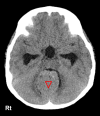Pediatric Neurogenic Pulmonary Edema After Brain Tumor Removal Complicated with Severe Myocardial Injury: A Case Report
- PMID: 38711258
- PMCID: PMC11087668
- DOI: 10.12659/AJCR.943645
Pediatric Neurogenic Pulmonary Edema After Brain Tumor Removal Complicated with Severe Myocardial Injury: A Case Report
Abstract
BACKGROUND Neurogenic pulmonary edema (NPE) is a rare complication of neurological insults, such as traumatic brain injury and intracranial hemorrhage, in children. NPE frequently accompanies left ventricular (LV) dysfunction mediated via central catecholamine surge and inflammation. A high serum natriuretic (BNP) level was prolonged even after the LV contraction was improved in this case with severe myocardial injury. The overloading stress to the LV wall can last several days over the acute phase of NPE. CASE REPORT A 6-year-old boy developed NPE after the removal of a brain tumor in the cerebellar vermis, which was complicated by hydrocephalus. Simultaneously, he experienced LV dysfunction involving reduced global contraction with severe myocardial injury diagnosed by abnormally elevated cardiac troponin I level (1611.6 pg/ml) combined with a high serum BNP level (2106 pg/ml). He received mechanical ventilation for 4 days until the improvement of his pulmonary edema in the Intensive Care Unit (ICU). On the next day, after the withdrawal of mechanical ventilation, he was discharged from the ICU to the pediatric unit. Although the LV contraction was restored to an almost normal range in the early period, it took a total of 16 days for the serum BNP level to reach an approximate standard range (36.9 pg/ml). CONCLUSIONS Even in a pediatric patient with NPE, we recommend careful monitoring of the variation of cardiac biomarkers such as BNP until confirmation of return to an approximate normal value because of the possible sustained overloading stress to the LV wall.
Conflict of interest statement
Figures



Similar articles
-
Could cardiac biomarkers predict neurogenic pulmonary edema in aneurysmal subarachnoid hemorrhage?Acta Neurochir (Wien). 2017 Apr;159(4):705-712. doi: 10.1007/s00701-017-3091-6. Epub 2017 Jan 30. Acta Neurochir (Wien). 2017. PMID: 28138770
-
The prognostic value of left ventricular systolic function and cardiac biomarkers in pediatric severe sepsis.Medicine (Baltimore). 2019 Mar;98(13):e15070. doi: 10.1097/MD.0000000000015070. Medicine (Baltimore). 2019. PMID: 30921240 Free PMC article.
-
Plasma brain natriuretic peptide and troponin levels in severe sepsis and septic shock: relationships with systolic myocardial dysfunction and intensive care unit mortality.J Intensive Care Med. 2014 Jul-Aug;29(4):229-37. doi: 10.1177/0885066612471621. Epub 2013 Jan 1. J Intensive Care Med. 2014. PMID: 23753226
-
Neurogenic pulmonary edema during intracranial endovascular therapy.Neurocrit Care. 2004;1(4):423-7. doi: 10.1385/NCC:1:4:423. Neurocrit Care. 2004. PMID: 16174944
-
Neurological Perspectives of Neurogenic Pulmonary Edema.Eur Neurol. 2019;81(1-2):94-102. doi: 10.1159/000500139. Epub 2019 May 22. Eur Neurol. 2019. PMID: 31117074 Review.
References
-
- Baumann A, Audibert G, McDonnell J, Mertes PM. Neurogenic pulmonary edema. Acta Anaesthesiol Scand. 2007;51:447–55. - PubMed
-
- Nastasovic T, Milakovic B, Marinkovic JE, et al. Could cardiac biomarkers predict neurogenic pulmonary edema in aneurysmal subarachnoid hemorrhage? Acta Neurochir (Wien) 2017;159:705–12. - PubMed
-
- Nguyen TT, Hussain E, Grimason M, et al. Neurogenic pulmonary edema and acute respiratory distress syndrome in a healthy child with febrile status epilepticus. J Child Neurol. 2013;28:1287–91. - PubMed
Publication types
MeSH terms
Substances
LinkOut - more resources
Full Text Sources
Research Materials

